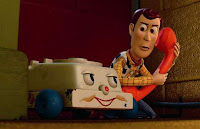Once again, I'm looking back at previous installments of some of this summer's big returning franchises.
By the time Pixar got around to Toy Story 3, 11 years after the release of Toy Story 2, the property was deeply entrenched as a major part of people's childhoods -- and their adulthoods, too, thanks to the relatable themes of growing up and moving on. The third movie really leans into those themes, with a story that repeats a lot of the plot elements of the second movie, but with higher stakes, more intense emotions and more beautifully rendered computer animation. Often regarded as the best movie in the series, Toy Story 3 gets a little too emotionally manipulative for my tastes, but it's still wonderfully entertaining and emotionally rich, a perfect capper to the trilogy (even if a fourth movie is on the way this week).
Once again, the toys are worried about being discarded, this time because Andy is all grown up and headed to college. And once again, a mix-up leads to some of the toys being carted off to an unfamiliar place, in this case to the seemingly idyllic Sunnyside Daycare. While in Toy Story 2, it was just Woody (Tom Hanks) who'd been taken away, here it's Buzz Lightyear (Tim Allen) and all the remaining supporting toys who get donated to Sunnyside, and Woody, who's been packed away to join Andy in his college dorm, must break in and save them from being demolished by reckless toddlers. So there's another rescue mission in another location where the toys meet a whole bunch of new characters, only this time the stakes are even higher (by the end, the toys are in imminent danger of being incinerated).
Still, the Sunnyside location is impressively envisioned, and the tyrannical Lots-o'-Huggin' Bear (Ned Beatty) is easily the series' best villain. Woody's fixation on staying with Andy at all costs is starting to get a little tiresome by this point, and the reversion of Buzz to an oblivious simpleton who thinks he's an actual Space Ranger seems like a step backward for the character, who's never been as fully developed as Woody in the later movies. All of the plot and character elements come together perfectly in the central prison-break sequence, though, which is far more elaborate than the breakout in Toy Story 2 and benefits from even further advances in computer animation. The new and returning characters fit together well to create an immersive world of toy-based conflict.
And then the movie kind of overplays its hand with the climax at the garbage dump, which puts the toys in actual mortal peril for the first time, and features multiple fake-outs that string the audience along (even though it's obvious that Disney/Pixar isn't going to kill off some of its most popular characters in a movie aimed at kids). The final scene between Andy and young Bonnie, as he passes his toys to a new generation, is equally manipulative in a different way, pressing way too hard on the feelings of nostalgia and regret that were more gently evoked in the second movie. Sure, it gets (mostly adult) viewers to cry, but it's a little cheap. That said, the overall sentiment is lovely, and it does find a satisfying way to end the story, while emphasizing the circle of life (to quote another Disney movie). If Pixar is getting corporate pressure to keep returning to this well, at least they do justice to it each time.




No comments:
Post a Comment